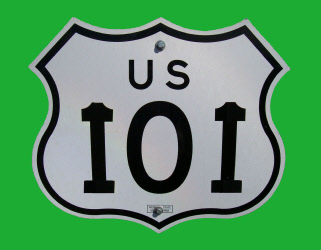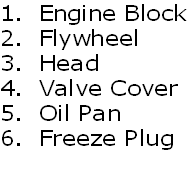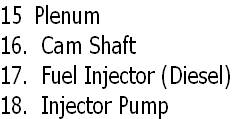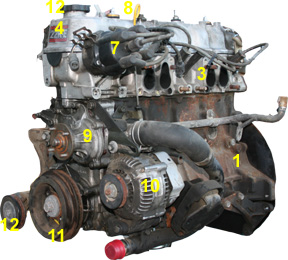

So you don’t know squat about your car?
As the title of this chapter implies, you don’t know shit about your car. I know that! You came to the website didn’t you?
Well anyway, let’s get down to the nitty gritty.
You put the key in the hole and turn it, then the engine makes noise. The engine makes more noise when you step on the long pedal on the right, and the wheels go round and round. You step on the wide pedal on the left (or center), and the wheels stop going round and round. This seems to be what most people know about their car. Oh yea, the slippery goo need to be changed one in a while, remember that. So let me tell you how the wheels go round and round.
When you turn the key forward, the solenoid engages the starter into the flex plate
(or flywheel) and turns the motor over, making the pistons go up and down inside
the cylinders. As the piston goes down, it draws in air through the plenum into
the intake valve. A fuel injector squirts gasoline into the air as it passes through
the plenum where it vaporizes and mixes with the air. The piston goes up, compressing
the air-
If the engine runs on diesel fuel, the whole process is essentially the same as a gasoline powered engine, except that rather than injecting the fuel into the plenum, the fuel is injected directly into the cylinder at the top of the compression stroke where it ignites spontaneously (no spark plugs needed).
This process continues over and over again in multiple (normally 4, 6, or 8) cylinders, turning the crankshaft. As the crankshaft is turned by the pistons, it, in turn, turns the flex plate (or flywheel) and the torque converter (or clutch). The power is then transferred into the transmission, turning the driveshaft, the differential, and then, finally the wheels. The flywheel also acts to keep the engine spinning via centrifugal force.
If your car is four or all wheel drive, you apply power to all four wheels via a transfer case. You will be able to transfer from two to four wheel drive using a lever or button. Some vehicles have an automatic four wheel drive feature that varies power to individual wheels. Leave this button off unless conditions warrant it. Many four wheel drive systems are not made for use on the street under normal conditions and may be damaged if used on the highway. Leave your transfer case in two wheel drive unless conditions warrant four wheel drive.
All wheel drive is continuous four wheel drive, made for on and off highway use. This is quite often the same as the automatic four wheel drive. All four wheels have power all the time, but you can’t turn all wheel drive off.
Three types of transmissions are currently being used in automobiles; the manual, the automatic, and the CVT.
A manual (a.k.a. stick) uses a clutch to transfer power from the flywheel and to release power when shifting gears. A series of selectable gears and synchronous mesh help vary the power transferred to the wheels.
An automatic transmission uses pressurized hydraulic fluid, clutch packs, and gears to transfer and vary the power to the wheels, and shift gears.
A CVT or Continuously Variable Transmission is two pulleys and a belt. The pulleys expand and constrict to vary the amount of power to the wheels.
Of these three types of transmissions, the automatic is less reliable, but easier
to use, and is in most of the cars and trucks in the U.S. The manual is more reliable,
but takes some skill to use, and clutches need to be replaced. The CVT is a relatively
new technology (in cars) that has yet to prove its reliability, but so far it seems
promising. Each of these types of transmissions come in front (transverse mounted),
rear wheel drive, and four-
Aside from the drive train as described above, the engine has multiple other “systems”. These systems include the cooling system, charging/electrical system, intake system, exhaust system, and air conditioning.
The cooling system keeps the engine cool. The water pump circulates cooled coolant
(ethylene glycol and water) through the heads and engine block. The heat from fuel
being burned in the cylinders is transferred to the coolant as it flows through the
water jacket. The heated coolant flows into the radiator. The radiator has tubular
fins that the coolant flows through. As the vehicle moves, air is forced through
the radiator fins, cooling the coolant, which is then re-
The electrical system runs the lights, radio, starter, sparkplugs, etc. All the electrical gadgets are powered by the battery, which is constantly charged by the alternator via the voltage regulator. The timing (a.k.a. ignition) is part of the electrical system. A cam or crank position sensor tell a computer which specific coil pack to send a spark to the sparkplug Older cars use a mechanical distributor. It directs the spark, created in the coil, to the proper spark plug at the proper time. Most modern cars have computer controlled ignitions, but there are still cars with caps and rotors.
The intake system is where the fuel and air are mixed and the speed of the engine is controlled. Cold air is sucked into the intake through the air filter, passes through the air mass sensor that tells the computer how much air is moving through the intake and how much fuel to inject into the intake, and may be forced the rest of the way with a turbo charger or supercharger. Most cars are naturally aspirated (no turbo or supercharger), thus the air is drawn into the engine solely by suction created by the intake stroke of the pistons. The throttle (the gas pedal) controls the amount of air drawn into the engine through a butterfly valve that you open and close by varying pressure on the gas pedal. The air is drawn through the plenum or manifold where the air becomes warm. The fuel pump sends the fuel to the injection pump and to the fuel injectors where it sprays into the hot air in the manifold and is drawn through the intake valves and into the cylinders to be burned.
The exhaust system relieves the engine of the products of combustion. Once the
octane becomes carbon monoxide, carbon dioxide, and water, it is forced out of the
cylinders through the exhaust valves, and passes down the exhaust pipe to the catalytic
converter, then out to the atmosphere. The catalytic converter becomes superheated
and finishes burning unburned fuel, carbon monoxide, and nitrogen oxides to reduce
smog. Diesel engines do not have catalytic converters, but starting in 2011, new
diesels require an exhaust catalyst that lasts about 7 to 10 fill-
The air conditioning system is driven by the engine, so it deserves a mention as part of the engine, but has no direct relationship with the operation of the engine. The engine spins the compressor which compresses the Freon™ and pumps it to the evaporator, where a fan blows air across the evaporator and into the cab. The Freon then goes to the condenser where it releases the heat gained in the evaporator. The last step is the same as the first step, compressing the Freon.
That cold air from the air conditioner had to be directed somewhere, thus is the ventilation system. This is a series of ducts and vents usually pointing at the windshield, cab, and floor. Older cars use vacuum from the engine or levers to open and close ducts that direct the airflow to one of three positions or combination of. Modern cars use servo motors to operate the vents.
Power steering is also driven off of the engine. It is just a hydraulic pump and rams assisting you to move the wheels when you steer. Many cars now come with electronic power steering.
This is how the wheels on the bus go round and round.






pistons. Almost all accessories bolt onto the block.
2. Flywheel: Transfers power to clutch. Also has ring gear for starter to
turn engine. This is not a flexplate, but serves almost the same purpose.
3. Head: Carries camshaft, valves, intake and exhaust ports.
4. Valve Cover: Covers top of head. Frequent source of oil leaks.
5. Oil Pan: Holds motor oil.
6. Freeze Plug: If coolant inside the engine freezes, instead of cracking the
block as it expands, the freeze plugs pop out and can be easily replaced.
May be cause of coolant leaks.
7. Distributor: Sends spark from coil to appropriate sparkplug.
8. Woops, missed one.
9. Water Pump: Pumps coolant throughout the engine.
10. Alternator: Makes electricity, Charges battery.
11. Harmonic Balancer: Bolted onto end of crankshaft. Drives all accessory
Belts.
12. Idler Pulley or Tensioner: Keeps tension on the belts.
13. Oil Cap: Fill the engine with oil here.
14. Oil Dipstick: Checks oil level.
15. Plenum of Intake Manifold: Air move through here from the throttle body
to heads.
16. Cam Shaft: Rotates via the timing belt or chain. Opens intake and/or
exhaust valves.
17. Fuel Injectors: Inject and vaporize fuel into the engine.
18. Injector Pump: Increases pressure of fuel to the fuel injectors. Normally
used only in diesel engines.
